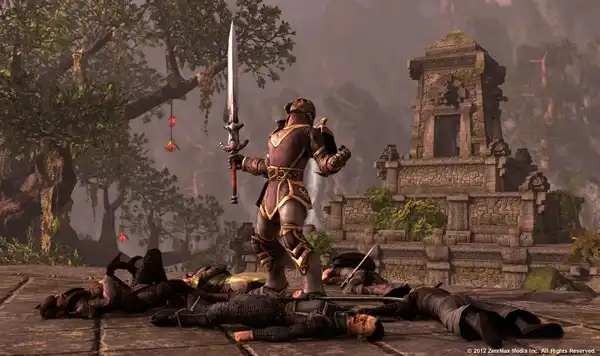E3 Day One – Bethesda
Events
The Elder Scrolls Online
When I flashed my press pass at the reception desk, I was corralled into a sub-booth area, where replicas of various arms and armor from Tamriel, the setting of The Elder Scrolls series, could be found. Like any Bethesda game, these were accompanied by lengthy descriptions of the historical and cultural significance of each item. Beyond them sat a throne, flanked by Nordic and Elven armors and an Elder Scroll, laid out on a drafting table.
Just as I finished reading, Bethesda reps appeared and herded the crowd of press into a small theater, where they started showing us footage of The Elder Scrolls Online, an upcoming MMO set in the same universe as Skyrim, but hundreds of years earlier, and on a much larger scale. Cameras soared over cities all across Tamriel, revealing earlier, brighter visions of the world.
The designs were going for a high fantasy look with a brighter, more simple aesthetic. Three factions vie for the seat of power in Tamriel, which manifests in immense 100 vs 100 battles between them. Syngergies enhance skills in combat when you play with other classes. While still adhering to the hotkey bar mentality of traditional MMORPGs, Zenimax emphasizes the design of the game world itself, showing that the UI hides itself when not in use.
They also touted its quest structure, which encourages wandering from the beaten path, and encourages players to recognize the consequences of their actions in the story. The example shown to us depicted a quest to defeat a werewolf in the vicinity, but taking a side path along the way reveals another quest, which allows you to travel through time and lay a ghost-haunted battlefield to rest. The combat system appears to stray from the conventional mode of watching cooldown bars, and feels more like action-based resource management.
Yet, I couldn’t escape the feeling that its gameplay still progresses according to World of Warcraft’s formula. As much as they extolled its differences and improvements, I couldn’t help but roll my eyes as I watched the character bend down and begin harvesting a number of quest items, presumably for a fetch quest.
Dishonored
After Zenimax finished their end, representatives from Arkane studios began talking about Dishonored, a stealth-based action game set in the city of Dunwall. The setting borrows much from the steampunk genre, but without the gaudy gleam of extraneous brass gears. Instead, the world feels like an exercise in opposites, ranging from the dirty grime of the streets to the bright, colorful world of the wealthy. The entire city runs on whale oil, a somewhat refreshing departure from familiar steampunk MacGuffins.
With a variety of tools and powers at your disposal, the game allows you considerable leeway in how you address and transcend its many challenges. Arkane’s presentation showed two approaches to the same situation – the first subtle, stealthily approaching one’s victims, and the second displayed a brutal bloodbath, where none in the character’s path were spared. As we exited the dark theater, I got my hands on a demo of the game, and despite my continued failures, I found myself enjoying the free tactics and interesting power combinations at my disposal.

Whether you teleport yourself to high ground, possess NPCs and use them to reach past obstacles, or simply summon a horde of rats to frighten and distract enemies, the game invites you to try something different each time you play it, and gives you the tools you need to do so. I walked away with a strong feeling that this game would be eating up an unhealthy portion of my free time after its release.
